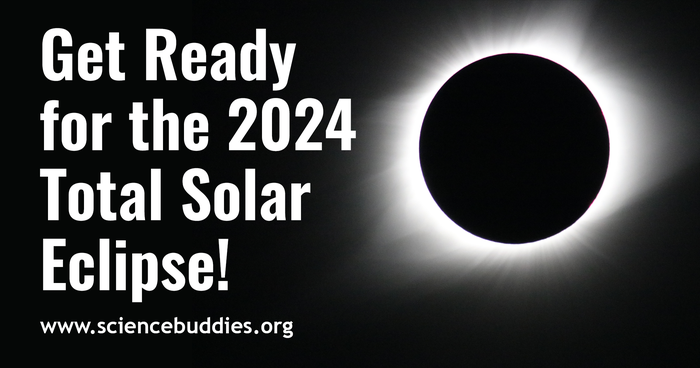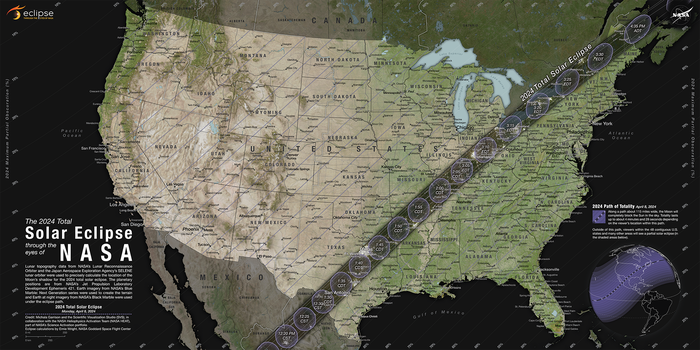Plan for the 2024 Total Solar Eclipse
Are you in the path of totality for the April 2024 solar eclipse? What will you and your students see? What related science projects can students do to learn more?

Solar Eclipse Science for Students
What happens when the Moon passes between the Earth and the Sun? A solar eclipse!
During a solar eclipse, the Moon blocks some or all of the Sun and casts a shadow on the Earth.
The Sun is about 400 times bigger than the moon, and it is about 400 times farther away. Given these differences, it is incredible that they line up just right now and then to cause a total eclipse. The video below from NASA offers a basic explanation and highlights the difference between an annular (or partial) and total solar eclipse:
Depending on where you are located, the Moon passing in front of the Sun may block your view of part of the Sun. During a total solar eclipse, if you are in the path of totality, the Moon will completely block the Sun, causing it to appear dark (like dusk) for a few minutes. During this time, the Sun's corona (its outer atmosphere) will be visible as a bright ring around the darkened Sun. (Fun fact! Just before and after the point of totality, the visible edge of the Sun, combined with the brightness of the corona, may appear to look like a "diamond ring" of light.)
For many people, witnessing a total solar eclipse may only happen once or twice in a lifetime!
2024 Total Solar Eclipse
On April 8, 2024, a total solar eclipse will be visible to many viewers in North America. The map below from NASA's Scientific Visualization Studio shows the path of the upcoming eclipse.

In the US, the path of totality (estimated to be between 108 and 122 miles wide) includes these states: Texas, Oklahoma, Arkansas, Missouri, Illinois, Kentucky, Indiana, Ohio, Pennsylvania, New York, Vermont, New Hampshire, and Maine. (If you are not in the path of totality, you may still experience a partial solar eclipse.)
How to View a Solar Eclipse
Safe viewing during the eclipse is a must! The few minutes when the Moon completely blocks the Sun is the only time you can safely look directly at the Sun.
Never look directly at the Sun without glasses (or a viewer) made specifically for that purpose.
Special solar viewing glasses are available for watching the eclipse. Making sure that the solar glasses (or viewers) you use are safe is very important. Solar glasses need to meet the ISO 12312-2 Standard for Solar Viewers. Make sure you purchase from a reputable source. See How Can You Tell If Your Eclipse Glasses or Handheld Solar Viewers Are Safe? for more information.
For additional information about safe viewing, see these guidelines from NASA.
Indirect Viewing with a Pinhole Projector
A pinhole projector (or pinhole camera) offers a simple way to indirectly observe the solar eclipse. This is a popular DIY STEM activity for viewing an eclipse without directly looking at the Sun. With a pinhole projector made from ordinary cardboard and paper, students can see the shadow of the eclipse cast on the paper. The video below provides an overview of how a pinhole projector works. (This same simple setup can also be used for a science project to measure the diameter of the Sun or Moon!)
The video below from NASA shows another way to build a pinhole projector using a cereal box. See also, How to Make a Pinhole Camera from NASA's Jet Propulsion Laboratory.
A pinhole projector (or pinhole camera) can be a fun way to talk about the eclipse or other experiments with light and shadow.
(Remember: a pinhole projector does not allow you to look directly at the Sun. This is an indirect viewing method.)
Related Science Projects
Before or after the eclipse, students may be interested in related astronomy projects like these:
- Measuring the Diameter of the Sun and the Moon: use a pinhole projector to measure the diameter of the Sun (and Moon).
- A Puzzling Parallax: use hula hoops to explore how the relationship between the distance of an object and the viewing perspective (parallax) can be used to determine how far away stars are.
- Star light, Star bright: How Does Light Intensity Change with Distance?: investigate the key relationship between brightness and distance.
- How Old Is the Universe?: use data about globular clusters (groups of stars) to estimate the minimum age of the universe.
- Finding the Center of the Milky Way Galaxy Using Globular Star Clusters: analyze data about globular clusters to determine a best-guess location for the center of the galaxy.
The following related lesson plans and resource collections are available for educators:
- Kinesthetic Astronomy: Moon Phases
- Kinesthetic Astronomy: The Meaning of a Year
- Explore Shadows with a Shadow Play
- Sun and Solar Science Projects
- 14 Science Projects and Lessons About the Solar System
Other Resources
- Video: What Is a Solar Eclipse? (NASA Space Place)
- NSTA Solar Eclipse Guide for Educators
- Exploring Solar Eclipses (National Air & Space Museum): contains two activities to make a DIY model to demonstrate what an eclipse is
The next time a total solar eclipse will be visible in the US will be August 23, 2044.












